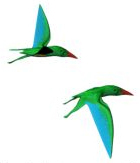Biology:Nemicolopterus
| Nemicolopterus | |
|---|---|

| |
| Holotype specimen | |
| Scientific classification | |
| Domain: | Eukaryota |
| Kingdom: | Animalia |
| Phylum: | Chordata |
| Order: | †Pterosauria |
| Suborder: | †Pterodactyloidea |
| Clade: | †Tapejaromorpha |
| Genus: | †Nemicolopterus Wang et al., 2008 |
| Type species | |
| †Nemicolopterus crypticus Wang et al., 2008
| |
Nemicolopterus is a dubious genus of tapejaromorph pterosaur, based on a very small specimen described as the smallest known "adult" pterosaur to date. It lived in the Jehol Biota 120 million years ago.
Discovery and naming
The generic name "Nemicolopterus" comes from the following Greek words: "Nemos" meaning "forest", "ikolos" meaning "dweller", and Latinised "pteron" meaning "wing". The specific name crypticus is from "kryptos", meaning "hidden". Thus "Nemicolopterus crypticus" means "Hidden flying forest dweller".
Description
The type fossil specimen of N. crypticus, catalog number IVPP V-14377, is housed in the collection of the Institute of Vertebrate Paleontology and Paleoanthropology in Beijing, China. The fossil was collected from the Jiufotang Formation, which is of Aptian age (120 mya). It was discovered in the Luzhhouou locality of Yaolugou Town, Jianchang County, Huludao City, western Liaoning Province in northeastern China . It has a wingspan of slightly under 25 centimeters (10 in), making it smaller than all but a few specimens of hatchling pterosaurs.[1] Wang et al. (2008), who originally described the specimen, concluded that it was immature, citing the amount of bone fusion and the ossification of the toes, gastralia, and sternum as indicating that it was a sub-adult rather than a hatchling. However, Darren Naish argued on his popular weblog that, due to the hypothesis that pterosaurs were highly precocial, bone fusion and ossification could have occurred very early in life, and that Nemicolopterus might in fact be a hatchling individual of the genus Sinopterus.[2] This identification was formally presented in 2021 study, which found that Nemicolopterus fit into a growth series as a young juvenile or hatchling Sinopterus hatchling.[3]
Classification
An analysis of pterosaur relationships by Andres and colleagues in 2014 found the specimen in a sister group relationship with "Sinopterus" gui.[4]
A 2023 revision of Sinopterus concluded that it was impossible to assign the Nemicolopterus specimen to either Sinopterus or the new genus Huaxiadraco, and it was therefore considered an indeterminate sinopterine.[5]
See also
- List of pterosaur genera
- Timeline of pterosaur research
- Pterosaur size
- Smallest organisms
References
- ↑ Wang, X.; Kellner, A. W. A.; Zhou, Z.; de Almeida Campos, D. (12 February 2008). "Discovery of a rare arboreal forest-dwelling flying reptile (Pterosauria, Pterodactyloidea) from China". Proceedings of the National Academy of Sciences 105 (6): 1983–1987. doi:10.1073/pnas.0707728105. PMID 18268340.
- ↑ "Tiny pterosaurs and pac-man frogs from hell". ScienceBlogs. 19 March 2008. https://scienceblogs.com/tetrapodzoology/2008/03/19/tiny-pterosaurs-pacman-frogs.[unreliable source?]
- ↑ Naish, Darren; Witton, Mark P.; Martin-Silverstone, Elizabeth (22 July 2021). "Powered flight in hatchling pterosaurs: evidence from wing form and bone strength". Scientific Reports 11 (1): 13130. doi:10.1038/s41598-021-92499-z. PMID 34294737. Bibcode: 2021NatSR..1113130N.
- ↑ Andres, Brian; Clark, James; Xu, Xing (May 2014). "The Earliest Pterodactyloid and the Origin of the Group". Current Biology 24 (9): 1011–1016. doi:10.1016/j.cub.2014.03.030. PMID 24768054.
- ↑ Pêgas, Rodrigo V.; Zhou, Xuanyu; Jin, Xingsheng; Wang, Kai; Ma, Waisum (2023). "A taxonomic revision of the Sinopterus complex (Pterosauria, Tapejaridae) from the Early Cretaceous Jehol Biota, with the new genus Huaxiadraco". PeerJ 11: e14829. doi:10.7717/peerj.14829. PMID 36788812.
Wikidata ☰ Q31650 entry
 |


